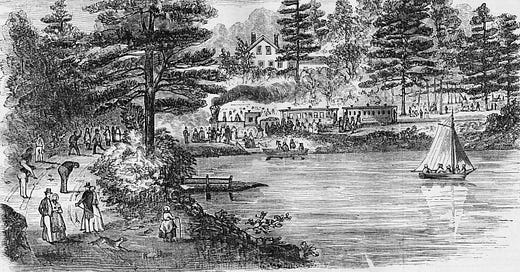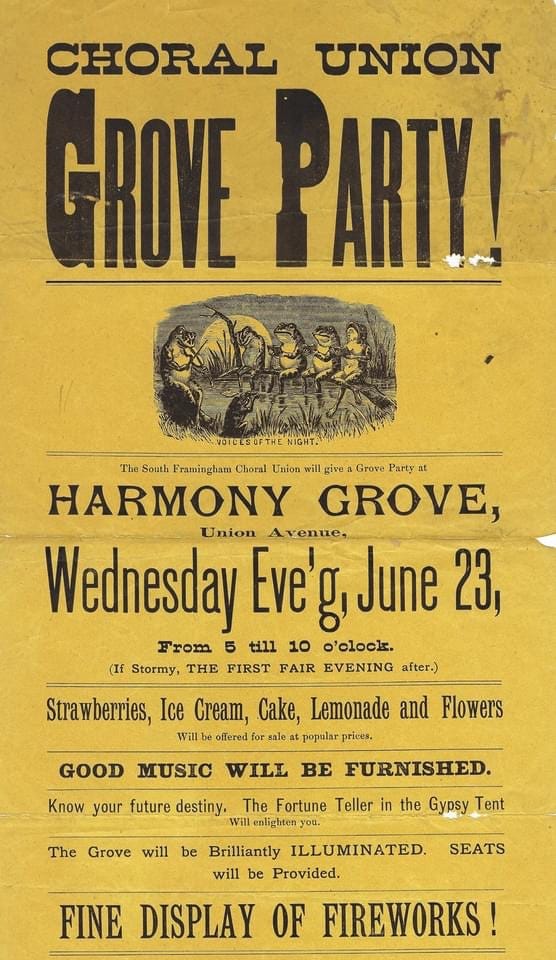Happy Independence Day week, America!
As we celebrate our nation’s birthday and Framingham’s 325th anniversary, I believe it is always an excellent time to reflect on who we are, our history, and our values.
Each year I write about Harmony Grove along Farm Pond and the famous abolitionist rally on July 4, 1854. It is an important part of our history that left a deep imprint on the soul of Framingham.
Let us begin…
On the banks of Farm Pond
Thousands gathered at Farm Pond to celebrate our community and America’s birthday last Friday. Food trucks sold tasty treats, bands played fun and patriotic tunes, families and friends picnicked and enjoyed the fireworks lighting up the sky.
Hundreds of years before a TikTok influencer discovered the beauty of Farm Pond, this area has a long tradition of being our natural gathering spot.
Across the pond near the train yard once stood Harmony Grove, a natural amphitheater. During the 1800s, it was the site of ceremonies, protests, events, and even family reunions. Families picnicked, people hiked and sailed boats, children played games, and parties and dances took place on the shore.
The land was first purchased by Edwin Eames, one of Framingham’s earliest families, in 1846. According to Framingham: An American Town by S.W. Herring:
“He cleared lawn areas for games, set up swings, built a dancing pavilion and a boathouse, and called it Harmony Grove. He also cleared a natural depression in the ground and put in a platform and benches to seat a thousand people for public rallies and meetings”
With the expansion of the railway between Boston and Worcester, Harmony Grove became the perfect location for events.
A Place of Dissent, Not Disorder
Among the groups who used Harmony Grove was the Massachusetts Anti-Slavery Society.
Every July 4th they held rallies attended by thousands of people who came from near and far to protest slavery in the United States.
July 4, 1854 was the most legendary of these rallies. Speakers at the event included Henry David Thoreau, Sojourner Truth, Wendell Phillips, Lucy Stone and William Lloyd Garrison. Records state 2,000 people were in attendance.
The months leading up to the rally were ones of turmoil. Congress passed the Kansas-Nebraska Act, permitting western settlers to legally establish slavery in the territories, and overturning the Compromise of 1820.
Here in Boston, the city was up in arms over the Anthony Burns trial. Burns was an escaped slave who was arrested in Boston under the Fugitive Slave Act of 1850. The Fugitive Slave Act was extremely resisted in Boston. The trial gained national publicity, large demonstrations, protests, and violence. President Franklin Pierce called in the United States Marines to Boston to aid the police in preventing more violence and ensure Burns boarded a Virginia bound ship after his trial.
On the heels of the violence, protest, and outreach, stood a stage in the amphitheater, decorated with two white flags with the names of Kansas and Nebraska and banners proclaiming "Virginia" and "Redeem Massachusetts." An inverted U.S. flag draped with black crepe hung above the stage.
Garrison, the publisher of the abolitionist newspaper The Liberator, spoke first and burnt a copy of the Fugitive Slave Act, followed Judge Edward G. Loring's decision to send Anthony Burns back to slavery, and finally the U.S. Constitution.
The July 4th meetings continued throughout the Civil War. After the war, the focus of events and rallies turned to women’s suffrage and temperance.
July 4, 1870 Garrison returned to Harmony Grove with Julia Ward Howe for a women's suffrage convention. Howe shared the stage with Abigail and Julie Smith of Connecticut.
The sisters “had been making the rounds of the suffrage circuit with the poignant and infuriating story of being required to pay taxes on their farm when they had no voice in the laws determining the levies and setting the rates. Their Jersey cows were sold at auction to satisfy their debt, making both the sisters (and the cows) martyrs to the cause of women's suffrage.” ("In a Goo d Cause": Framingham and the Fight for Women's Suffrage”.)
The July 4th rally in 1874 saw Lucy Stone return with keynote speaker Mary Livermore, who worked with Stone on her Woman's Journal newspaper. Livermore was instrumental in organizing a later suffragette meeting at the Chautauqua site at Mount Wayte, another Framingham institution that helped support and promote women's fight for vote.
By the 1870s, Harmony Grove’s popularity declined. The land was subdivided for houses and the expansion of the railroad yard.
It is amazing how the Farm Pond area, thanks to the railroad, was a prominent location for these meetings. It is important to note these events never caused any distraction or distress to neighbors or the neighborhood.
Raymond Callahan, the editor of the Framingham News, wrote a hundred years later that even though the topics discussed were the hot, emotional issues of the day, Harmony Grove was the site of “dissent without disorder.”
Harmony Grove Today
The natural amphitheater no longer exists, in fact you won’t find any remains of Harmony Grove.
There is a small plaque at the corner of Franklin and Henry Streets, across from Tommy’s Taxi, that marks Harmony Grove.
Fall 2021 Framingham Public Schools renamed Woodrow Wilson Elementary School to Harmony Grove Elementary School, after a student petition resulting in a community driven naming process. The legacy of Harmony Grove continues on.
In closing
Framingham residents, time and time again, have gathered to take a stand on the important issues of their time and used their voices to speak out for social justice and equality. Today we see that legacy continue on the steps of the Memorial Building or on the Centre Common where thousands of people gathered for No Kings Day. We use our freedoms of speech, press and assembly.
And as long as there is injustice in our country, Framingham residents will continue to use their freedoms and rights to gather and speak out.
Harmony Grove and Farm Pond are symbols of community. We are more divided as a country than ever, and there is more talking than listening. More negativity. More dragging people down, than lifting up.
Let’s take the lessons of Harmony Grove with us.
What can we do to bring attention to today’s issues and build community?
See you in the next issue,
Mary Kate









Great job summarizing the important history of Harmony Grove! Proud of the student-led process that led to the name of Harmony Grove Elementary School and that our Framingham community continues to speak out against injustice.
thank you for this, your timing is perfect. I was telling what I knew of this to a MassBay staffer, little did they know their new building is just down the street. Many years ago the historical society had a bus tour narrated by Steven Herring -- what a treat that was.
thanks again and Happy 4th!